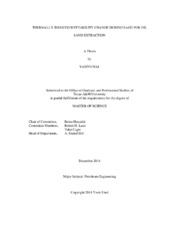| dc.description.abstract | Steam-assisted gravity drainage (SAGD) is an in-situ bitumen extraction technique that significantly increases ultimate oil recovery from oil sand reservoirs. Because SAGD is one of the newest proven thermal oil recovery techniques, laboratory test and field pilot efforts are in progress to enhance oil recovery by using less energy and water for steam generation. These efforts are simplified with the contribution of numerical simulations to optimize the oil recovery of SAGD projects.
Several critical parameters determine the reliability of numerical simulation for SAGD, and wettability is one of the most crucial parameters defining the microscopic displacement efficiency with the change in relative permeabilities, interfacial tension, and capillary pressure.
In this work, relative permeability as a function of temperature are determined during SAGD for bitumen extraction from oil sand reservoirs numerically. Three SAGD experiments are used to validate the accuracy of simulation studies. The effect of injection temperature and clay type in the formation on SAGD performance were investigated experimentally. Cumulative oil recovery, cumulative water production, and temperature distribution in time for each experiment are used as history-matching parameters of the numerical simulation.
Contact angle, zeta potential, interfacial/surface tension, residual fluid saturation, X-ray diffraction (XRD), and scanning electron microscope (SEM) measurements are conducted on produced oil, produced water, and spent rock samples to determine the relative permeability endpoint changes with temperature and with clay type in the formation. Three experimental results are combined with the experimental analyses on produced samples to numerically obtain the relative permeability change at each experimental condition.
Numerical results are in good agreement with the experimental findings. History-match is obtained in all three experiments by only changing the relative permeability endpoints, which proves the reliability of the numerical model and the relative permeability assumptions. For the case in which temperature is the only variable, relative permeabilities are adjusted to represent water-wet behavior at higher temperatures. For the case in which clay type is the only variable, relative permeability endpoints are tuned to better represent different wettability characteristics observed for each clay type. | en |


